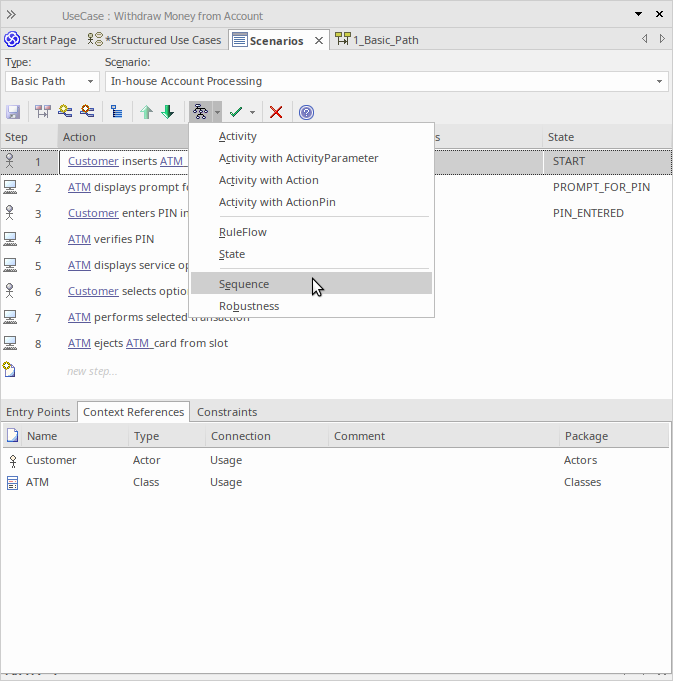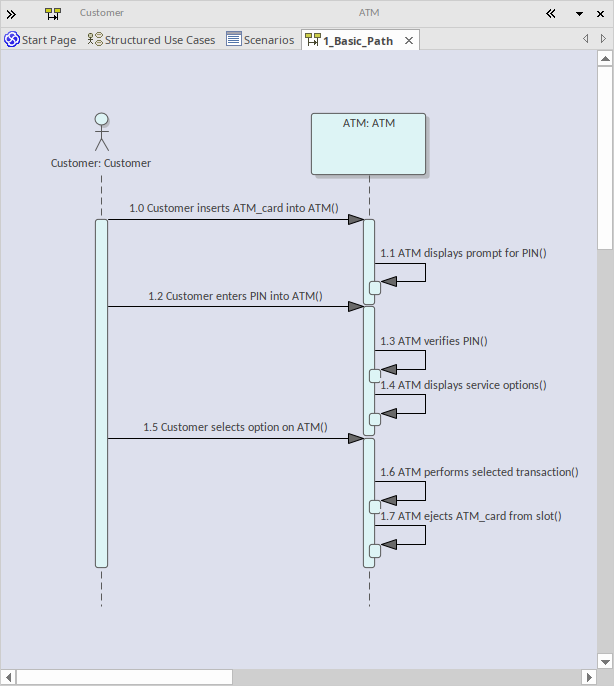How To Draw Sequence Diagram In Enterprise Architect
Generate Sequence Diagram
When you create a scenario on an element and then generate a Sequence diagram, an Interaction is created as a child of the selected element to act as a container for the diagrams - the Basic, Alternate and Exception paths are each modeled as a separate Sequence diagram under the Interaction. There are a number of points to note in this process:
- All the elements involved in the scenario must be identified in the 'Context Reference' tab; that is, relationships must already exist between the scenario parent element and the other elements named in the scenario (the Scenario is a Process, and the Sequence diagram is showing the flow of messaging between different Lifelines; for that to happen the lifeline/object has to be defined, which is achieved using a Context Reference)
- So, each Context Reference element named in a scenario step is modeled as a Lifeline
- The step itself becomes the Message between an originator and its destination(s)
- The first Context Reference element in a step is treated as the originator
- The subsequent Context Reference element(s) become the destination(s)
- Because the diagram generator acts on element names in the step, you must not use the element names as normal text; for example, in step 1 in the example dialog, the term ATM-Card is interpreted as a reference to the ATM element, and two 'Customer inserts ATM-Card into ATM' messages are generated for the step (to avoid confusion, in the diagram the first Message has been deleted)
- If you have not selected the 'Show Sequence Numbering' checkbox on the 'Diagram Sequence' page of the 'Preferences' dialog, the Message name on the Sequence diagram is prefixed by the step number, as shown in the example diagram in this topic; if you have selected the checkbox, the message sequence number is shown instead of the step number
- The values of the 'Uses', 'Results' and 'State' columns are added as Tagged Values of the Message
Access
On a diagram or in the Browser window, click on the element and select one of these access methods to display the Scenarios View, then click on  and select 'Sequence'.
and select 'Sequence'.
| Ribbon | Start > Desktop > Design > Scenario Editor |
| Context Menu | Browser window > Element | Scenarios | New Scenario > Scenario View Browser window > Element > Scenarios | right-click on existing scenario | Structured Scenario Editor |
| Keyboard Shortcuts | Alt+1 > Scenario Editor |
| Other | On the 'Scenarios' tab of the Responsibilities window, click on the Edit button against a scenario (see the Scenarios Tab - Responsibilities Window Help topic) On the 'Scenarios' tab of the element 'Properties' dialog, click on the Structure Editor button (see the Scenarios Tab - Properties Dialog Help topic) |
Example


Learn more
- Scenarios
- Scenarios Tab - Responsibilities Window
- Scenarios Tab - Properties Dialog
- Scenarios View
- Context Reference Tab
- Generate Diagrams
- Sequence
- Sequence Diagram
How To Draw Sequence Diagram In Enterprise Architect
Source: https://sparxsystems.com/enterprise_architect_user_guide/15.2/modeling/generated_sequence_diagram.html
Posted by: kellyanowbod1944.blogspot.com

0 Response to "How To Draw Sequence Diagram In Enterprise Architect"
Post a Comment